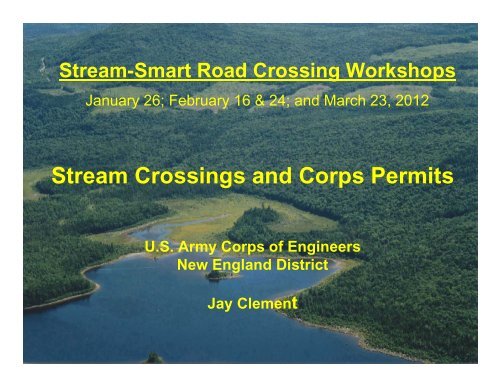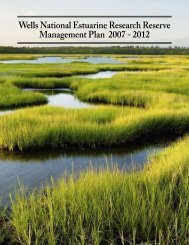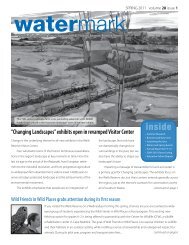Stream Crossings and Corps Permits - Wells National Estuarine ...
Stream Crossings and Corps Permits - Wells National Estuarine ...
Stream Crossings and Corps Permits - Wells National Estuarine ...
You also want an ePaper? Increase the reach of your titles
YUMPU automatically turns print PDFs into web optimized ePapers that Google loves.
<strong>Stream</strong>-Smart Road Crossing WorkshopsJanuary 26; February 16 & 24; <strong>and</strong> March 23, 2012<strong>Stream</strong> <strong>Crossings</strong> <strong>and</strong> <strong>Corps</strong> <strong>Permits</strong>U.S. Army <strong>Corps</strong> of EngineersNew Engl<strong>and</strong> DistrictJay Clement
PRESENTATION OBJECTIVE1. Clarify <strong>Corps</strong> of Engineers jurisdiction <strong>and</strong>permit program as it pertains to streamcrossings. “When do I need a <strong>Corps</strong> permit?”2. Review requirements of Maine GeneralPermit (“Maine GP”) as they relate to streamcrossings.
PERMIT AUTHORITIESWhat triggers <strong>Corps</strong> jurisdiction?Section 10 - Rivers <strong>and</strong> Harbors Act of 1899•Regulates work in navigable waters of the U.S.•Includes virtually all temporary & permanent work•Navigable waters = all tidal waters & other waterways that have been specificallydeclared navigable by CongressSection 404 - Clean Water Act of 1972•Regulates dredged & fill material discharges in waters of the U.S.•Includes ANY temporary or permanent fill as well as certainexcavation/demolition activities•Waters of U.S. = all navigable waters <strong>and</strong> all others (lakes, ponds, streams, <strong>and</strong>adjacent wetl<strong>and</strong>sNOTE: DEP or town permits are not a substitute for a <strong>Corps</strong> permit. Moststream crossings are within <strong>Corps</strong> jurisdiction, but not all require a writtenpermit.
PERMIT AUTHORITIESSection 10 - Rivers & Harbor Act of 1899Issue permits for work in navigable waters of the U.S.Work includes the installation of permanent ortemporary structures, filling activities, <strong>and</strong> dredging.Any work potentially affecting the course, location,condition or capacity of such waters.Navigable waters in Maine: All tidal waters;Penobscot River to Medway; Kennebec River toMoosehead Lake; & Maine portion of Lake Umbagog.Federal jurisdictional boundary: mean high water(MHW) lineVirtually any tidal crossing requires a <strong>Corps</strong> permit.
PERMIT AUTHORITIESSection 404 of the Clean Water ActIssue permits for the discharge of dredged or fill materialinto all waters of the U.S. including navigable waters aswell as their tributaries <strong>and</strong> adjacent wetl<strong>and</strong>s.Federal jurisdictional boundaries:•High tide line in tidal/navigable waters; ordinary high waterline in navigable waters•Wetl<strong>and</strong> boundaries are delineated using the Jan. ‘87 <strong>Corps</strong>Wetl<strong>and</strong> Delineation Manual & Regional SupplementNote: <strong>Crossings</strong> generally involve filling (cofferdams,bedding/backfill, riprap aprons, etc) <strong>and</strong> are thereforegenerally within <strong>Corps</strong> jurisdiction.
TYPES OF PERMITSMaine General Permit (Maine GP)• Abbreviated permit process (60 days)• Reserved for minimal impact projects• Two categories of review; non-reporting (Cat 1) <strong>and</strong>reporting (Cat 2)Individuals <strong>Permits</strong>• Reserved for more complex or controversial projects• Require public notice & full public interest review• <strong>Permits</strong> processed within 120 days
Maine GP<strong>Stream</strong> <strong>Crossings</strong> <strong>and</strong> the Maine GP (Category 1)Special Condition 22Requirements for Category 1 Eligibility (non-reporting)• Only applies to inl<strong>and</strong> waters, i.e. freshwater; tidal crossings go Cat 2• Generally shall not impede high flows or obstruct necessary lifecyclemovements of indigenous aquatic life• Footprint of impact in stream & wetl<strong>and</strong>s must be
Maine GPAn explanation of the 1.2 x Bank Full Width Design St<strong>and</strong>ardExample: BFW = 4’; Minimum culvert or arch diameter = 4.8’ (60” )
Maine GP<strong>Stream</strong> <strong>Crossings</strong> <strong>and</strong> the Maine GP (Category 2)Special Condition 22Recommendations for Category 2 Eligibility (reporting)• Same general requirement to pass flows & aquatic life• Same time of year restriction is preferred• Same preference for spans but oversized embedded culverts can be foundacceptable (GP has recommendations for minimum embedment). 1.2 xBFW remains the target design. No multiple pipes.• Slip lining/Invert lining still not preferred but can be acceptable on a caseby-casebasis e.g. with built-in baffles or weirs to aid in passage• Footprint of stream & wetl<strong>and</strong> impact must be < 3 acres• No adverse impact to federal endangered species or Critical HabitatCategory 2 requires application to <strong>and</strong> written approval to the <strong>Corps</strong> <strong>and</strong>allows for case specific determination by reviewers
Key Elements of Maine PGP ProcessAPPLICATION• DEP, LURC or <strong>Corps</strong> application form accepted• Clear, reproducible, & legible plans (locus map, plan view, &cross section(s)• Clear summary of project purpose & need• Clear summary of project impact• Discussion of avoidance <strong>and</strong> minimization measuresAGENCY REVIEW (May require Endangered Species Consultation)PERMIT ISSUANCECOMPLIANCE & ENFORCEMENT
Individual <strong>Permits</strong>Individual <strong>Permits</strong> <strong>and</strong> <strong>Stream</strong> <strong>Crossings</strong>• Reserved for crossings that do not meet GP st<strong>and</strong>ards (rare)• Reserved for any crossing that adversely affects federalendangered species (formal Section 7 consultation required)• Case by case determination• Pre-application coordination <strong>and</strong> site visits critical• State/Federal fisheries agency input likely• Emphasis on avoidance & minimization• Compensatory mitigation may be required
SOME ISSUESGeneral• Contradicting state/federal permit processes• Lack of outreach• Compliance/Enforcement• Cost of compliance with crossing st<strong>and</strong>ards• Exp<strong>and</strong>ing awareness of barrier issues• New species of concern – alewives, Atlanticsturgeon
CONTACT INFORMATION• U.S Army <strong>Corps</strong> of EngineersMaine Project Office675 Western Avenue, #3Manchester, Maine 04351• 207-623-8367 Ph.; 207-623-8206 FaxEmail: jay.l.clement@usace.army.mil• New Engl<strong>and</strong> District - Regulatory Divisionwww.nae.usace.army.mil/regulatory• USACE Regulatory Branch nationallywww.usace.army.mil/inet/functions/cw/cecwo/reg
QUESTIONS?????




